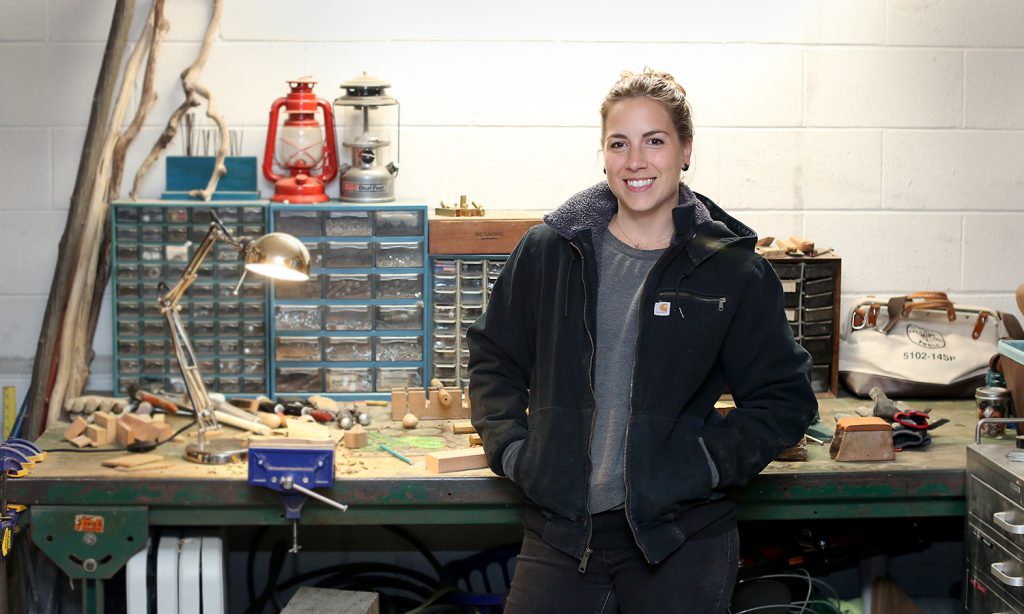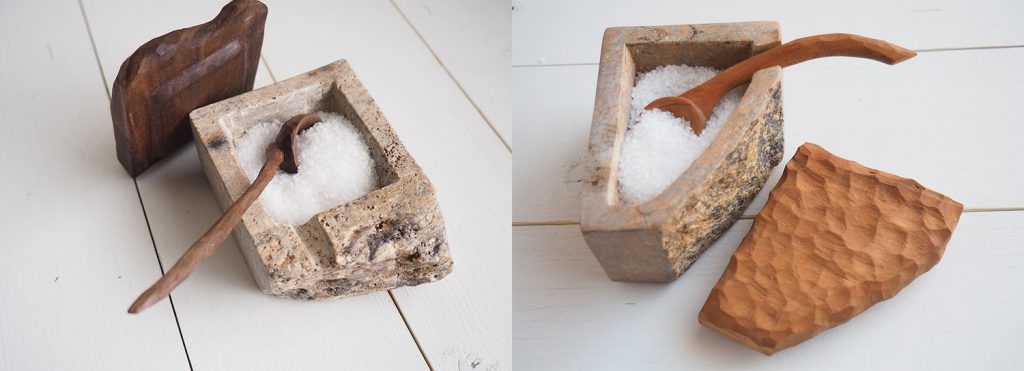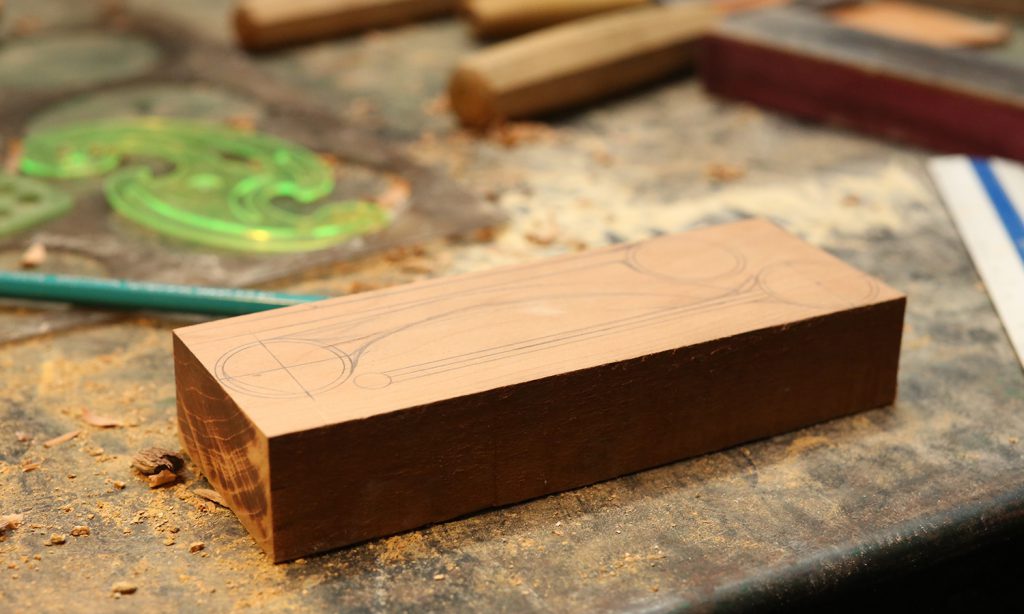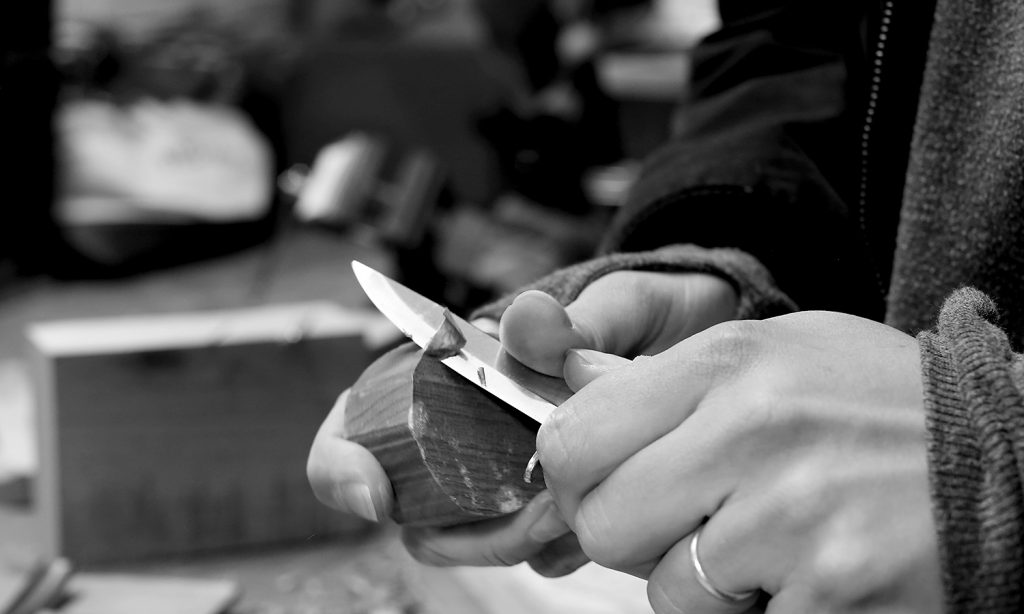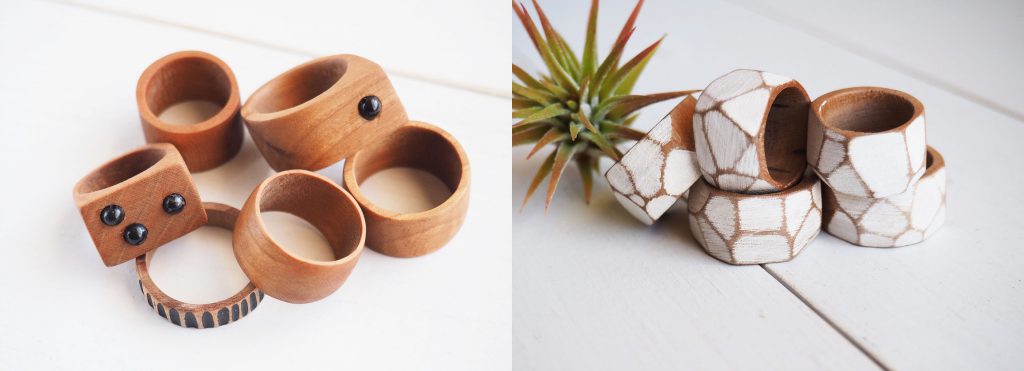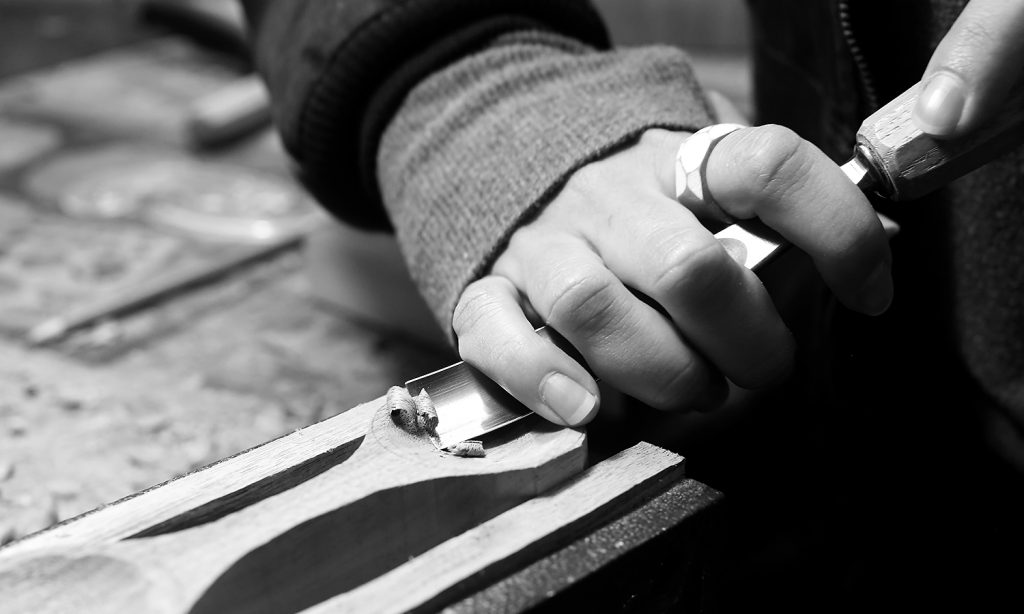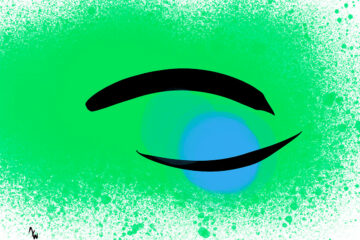In a single-car garage on Manitou Avenue, Christine Costa carves out her career break. An architect by trade, she and her husband, Dominic Costa, a welder, moved to Manitou Springs from the Detroit area this past summer.
Two motorcycles rest side by side in the garage. At the back wall is a workbench, a vise and assorted hand tools Christine, 32, uses to craft blocks of wood into beautiful, functional pieces. Spoons, salt cellars, valet trays and rings.
“We just wanted a mid-career break,” she says. “We up and moved out here — we planned it for, like, two years — and I started doing this to fill my time.
“We’ve been kind of pretending we’re retired. We do fun stuff, and go camping and hiking and fishing. It’s almost over. We gave ourselves six months.”
As Christine’s tools and works-in-progress sit idle, we talk about what not to do on a dirt bike, the value of a career sabbatical, and the meditative flow of her craft. We talk about how to avoid looking like a “weirdo” when standing in the middle of a river, soaking up Colorado nature. And we touch on the complicated relationship she has with her “baby,” the 1966 Honda motorcycle that accompanies her in her Deadtree Workshop.
Humanitou: Why Manitou? Did you already know this is where you wanted to be?
Christine: We kind of had an idea, because we had been vacationing here and we have family and friends in Denver. And we just love it out here. I love Utah and just being in driving distance of Utah is, like, “Yes, let’s do that.”
And Dominic loves the snow, so we couldn’t go anywhere without snow. And I love the desert, so this seemed like a really great place.
Humanitou: Are you going to stay here? Are you hoping to find jobs and restart your careers in the Manitou area?
Christine: Yeah, I think so. So far, we kind of love it. I’m excited about this winter. Everybody keeps telling me that winters in Colorado are amazing.
Humanitou: How did you get started in carving? Is it something new you started with this career break?
Christine: I started about a year and a half ago. I had this really great spot in my old house. I made the sun porch into a workshop. I would do it on a Saturday, and then we’d be busy for a month, and then I’d be able to do it again.
You know, you come home from work and you’ve got emails on your cell phone and you’re on all the time. It was constant. So, I was, like, “I want to do this. I feel like this would be really cool.” But I never had the time. So, I guess it just happened to fall and be the focus of this career break.
My dad had a cabinet shop when I was growing up, so I’ve been around wood, and I wanted to be a carpenter when I was younger, and then I became an architect. I was missing that working with your hands element.
So, I’ve zoned in on this. I like it. It’s challenging. It’s not like I can master it in a weekend and then get bored. This is hard, I think.
Humanitou: You went to school for six years to become an architect, and you’d been working with your firm for 10 years, since you were a sophomore. How did it feel to leave that behind?
Christine: It was the best job ever that I left. I kind of felt like I was doing some amazing stuff, some awesome projects with amazing people, but I kind of felt like I had plateaued a little bit.
Once you get to a certain point, you either have to stay the same or go into management, managing people. I didn’t want to do that. I liked what I was doing, but it felt like I needed a shake-up. People thought I was crazy. But nobody thinks I’m crazy out here.
Humanitou: That’s the conventional mindset, that you’re crazy to let go of relative security to chase your heart.
Christine: What’s the worst that can happen? Not much. I’m always going to be licensed as long as I keep up on it, renew it and continue education. I won’t stop being an architect. I love it. This was a mental break, hitting the reset button.
Humanitou: It seems you probably are using your architecture background in executing these wood carvings. For example, the precisely drawn plan on this block of wood for a spoon.
Christine: Yeah. What I like about this situation where I have really limited space, limited material, limited tools … those limitations, I feel, really get your creative juices flowing.
When I was working, it was limitations of ceiling height or a really big column in the middle of the room, or there’s a huge duct running through the space and you have to make it look good. But there are those opportunities, where it’s not just, “Let’s work around it.” The skill is in making that part of the design, instead of trying to hide it.
That’s kind of what’s happening here. At the Manitou Art Center, there are so many tools. I’m like, “There are so many tools, I want to go back to my little shop and work with my limited tools.”
Humanitou: I noticed on your Instagram page, among the great photos you’ve shot and posted of your carvings, you’ve been tenkara fly fishing. Is that a new thing with your new life in Colorado?
Christine: Yeah, totally new. I’ve never fished before. I mean, I fished when I was a kid with my dad. In lakes, you put a worm on the hook and dropped it in.
I wanted to fly fish, but we’re on a career break, which means we don’t have money coming in, so I can’t afford that, all the stuff they have. I knew even if I got all the stuff, if I didn’t like it, if I wasn’t good at it right away, I’d probably lose interest.
I saw this tenkara stuff and right away, “I could totally do that.” We’re catching teeny fish, but that’s okay. It’s something to do when hiking to alpine lakes; just throw it in your backpack.
Humanitou: I like the simplicity of tenkara. What do you think of it, so far?
Christine: You’re right, the simplicity. I like that. My first idea for fly fishing was I just wanted to be able to get some waders and be able to stand in the middle of a river without looking weird.
As long as you have a pole in your hand, you don’t look like a weirdo. I just wanted to walk in … “This is so gorgeous.” I’ve done that a couple times.
Humanitou: It looks like you and Dominic ride together, too.
Christine: Yeah. This is my baby. This is a 1966 Honda 305 Super Hawk. When I bought her, she was cobalt blue and had the big, silly handles. The seat was all ripped, but she ran really good. So, I tore the whole thing apart and made it look how I wanted it to look.
Humanitou: You did the work yourself?
Christine: Yeah. I have documentation of that. I took pictures of everything. I look back on it and I’m like, “I can’t believe I did that.”
Humanitou: It was a total learning process as you went?
Christine: Yeah. There are so many good forums on these bikes. As you need to learn something, you learn it. I kind of forgot a lot of it now.
I had everything sandblasted. And then we had to clean the tank, clean the paint out of the inside, and the rust. And I had to do this weird electronic thing with a hanger and a battery, and I can’t believe I did that. But it cleaned all the rust out of the inside.
The only I couldn’t do were the carbs, because that takes some skill. I took it to the Honda Doctor [in Michigan]. It was fun.
And then I rode it and I got in a little dirt bike accident and messed up my foot. Motorcycle accidents are weird. At first I wasn’t scared to get back on my bike, but it progressed really slowly to where I got more fearful.
It was like, “This is a weird evolution of my brain. What’s going on?” The reason I got into it was fixing it up and figuring out all the insides. That’s what I can keep doing, but I don’t really like to ride anymore.
But I have an excuse never to wear heels again for my whole life, which is pretty awesome. And people are like, “Why?” “Because I wrecked a dirt bike.”
It wasn’t very glamorous or very cool, but I did hurt myself and I can’t bend my big toe. (laughs)
Humanitou: What happened?
Christine: Wet grass, dirt bike, overconfidence. Not a good combination. (laughing) Went over the handlebars. I didn’t have a helmet on. I had on fashion boots and a tank top. I was not prepared. It could have been a lot worse. I’m lucky.
Then when you’re riding, in the middle of a ride, I’d start overthinking it. I was really stressed by the time I got home. I have a very complicated relationship with my bike. I like it. I like trying to figure it out in my head.
Humanitou: With this complicated relationship, is it nice to have her nearby while you work?
Christine: Absolutely. My ideal situation is to, eventually, have a house where I can have her in the living room. But then I can’t ride it. Then am I wasting this awesome motor that’s still running since 1966? It’s another complication. It’s kind of fun.
Humanitou: Would you say there is anything you are learning from this experience of a career break?
Christine: Oh, yeah. Don’t take your career so seriously. I think everyone, every 10 years or something, they should retire for a year. It just resets your priorities.
How most people’s jobs are now, with the cell phones and you’re constantly on, the first thing you do is get up and you answer emails, and then you go to work and you’re on that whole time and you’re on when you get home.
Since I was 16, I’d never taken more than two and a half weeks off. That can’t be right. Your whole life can’t be a job. You have to give yourself a chance to mess up and do other things. I had gone to college, then had my license and then had a great job, and was doing amazing stuff, but …
Humanitou: This immersion in wood carving in recent months, is there something you’ve learned about yourself during this time?
Christine: I think what I learned, I’m going to call it flow, because I don’t know what else to call it. It happens in meditation, mindfulness. It happened when I was drafting. I would be creating an elevation of a historic building and I would just get in it. That same thing happens when you get into making stuff, but even more so.
It’s really good for your brain. There’s something that’s really calming. I feel like it repairs, like sleeping repairs your body while you’re sleeping. The flow you get into does it, too, that focus you can stay in for a couple hours.
I would do it when I was working on the motorcycle, just the intense focus. You get into a really relaxed state. I think that’s really cool.
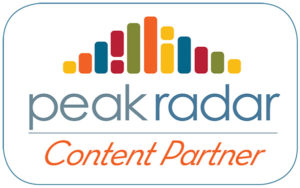 This Humanitou conversation is cross-posted at PeakRadar.com. | PeakRadar.com is the Pikes Peak region’s cultural calendar and digital cultural center, connecting residents and tourists with our vibrant arts community. Your source for what’s happening is PeakRadar.com!
This Humanitou conversation is cross-posted at PeakRadar.com. | PeakRadar.com is the Pikes Peak region’s cultural calendar and digital cultural center, connecting residents and tourists with our vibrant arts community. Your source for what’s happening is PeakRadar.com!
